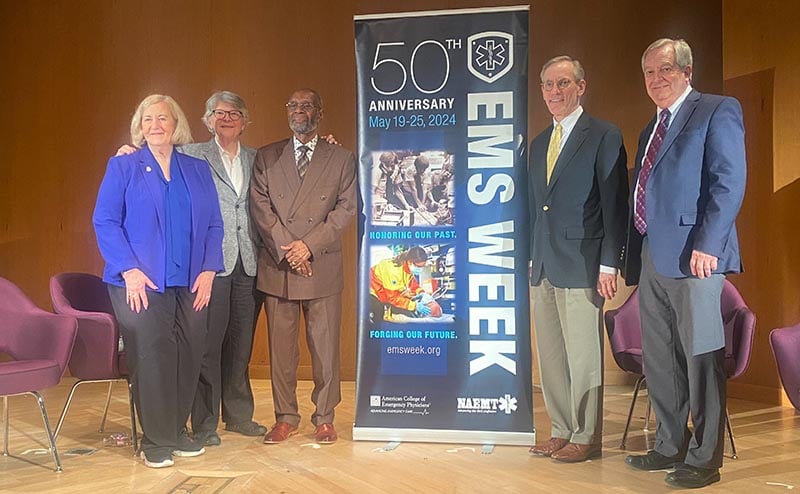Emergency Medical Services (EMS) has come a long way since the days of patients relying on funeral directors for transport to the emergency department. On Wednesday, the National Museum of American History explored the creation and growth of EMS in the United States as part of the 50th anniversary celebration of EMS Week™.
The day’s activities included historic ambulances parked in front of the museum, an exhibit of vintage medical equipment on prominent display, and a panel featuring EMS leaders and luminaries from across the country, facilitated by Katherine Ott, a curator of medical history for the museum.
The panelists included:
- John Moon, one of America's first paramedics, Freedom House ambulance service
- Robert Holman, MD, medical director at DC Fire & EMS
- Jon Krohmer, MD, FACEP, FAEMS, member of the Michigan College of Emergency Physicians and former director of the Office of EMS in the National Highway Traffic Safety Administration
- Mary Beth Michos, Senior Advisor, International Association of Fire Chiefs
Any discussion of EMS history begins with Freedom House, a nonprofit organization in Pittsburgh that would become known as America’s first Emergency Medical Service.
To call Mr. Moon a trailblazer only scratches the surface of what he and his colleagues at Freedom House accomplished.
Acknowledging racial tensions of the day and the Black community’s complex relationship with law enforcement, Mr. Moon said, “Everyone they trained was Black. We were labeled by society as least likely to succeed. Society made one mistake – they didn’t tell us.”
Freedom House had a pivotal role in EMS innovation. Mr. Moon is widely credited with completing the first intubation in the field by a paramedic. The Freedom House medical team was instrumental in ambulance design, blood pressure cuff placement, and onboard oxygen. They were the first to use cardiac resuscitation techniques on the way to the hospital and are credited with pioneering the use of naloxone for overdose, among other treatments that revolutionized emergency care.
Before EMS was formally organized, people injured in a motor vehicle accident were less likely to survive than soldiers hurt during the war in Vietnam, Dr. Krohmer noted. Times have certainly changed.
EMS is an indispensable part of any community, and EMS leaders can take credit for transforming the way patients receive care before they get to the hospital.
Dr. Holman points to present day developments in Washington, DC such as prehospital whole blood transfusions, buprenorphine administration, and EMS-driven programs meant to alleviate systemic strain, such as a nurse triage line.
“I’m standing on the shoulders of these pioneers,” he said.
Unwavering dedication to community service and steadfast commitment to public health and safety inspires EMS professionals from all generations.
“Somebody gave me an IV infusion of lights and sirens – I knew that’s what I wanted to do,” said Ms. Michos. “The most rewarding thing you can do out there is save a life.”
At their core, EMS professionals are problem solvers, and stepping up to help people on their worst days requires a certain mentality.
“EMS is at the intersection of health care, public safety, public health. If something needs to be done and EMS can figure out a way to do it, we will. That's what EMS folks are all about,” said Dr. Krohmer.





